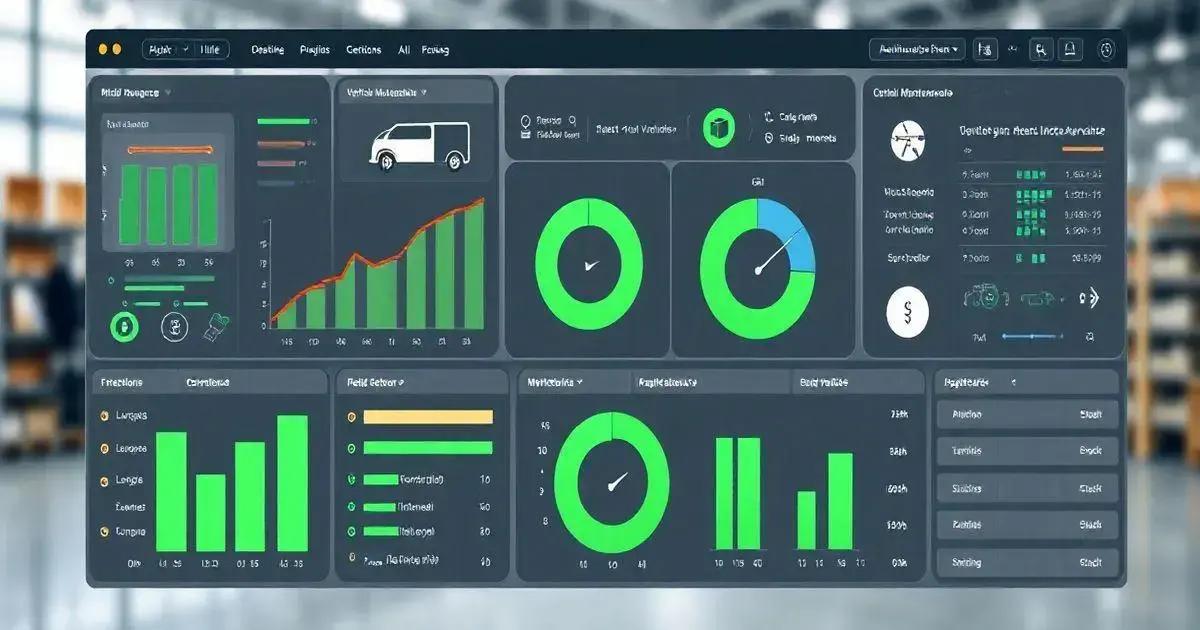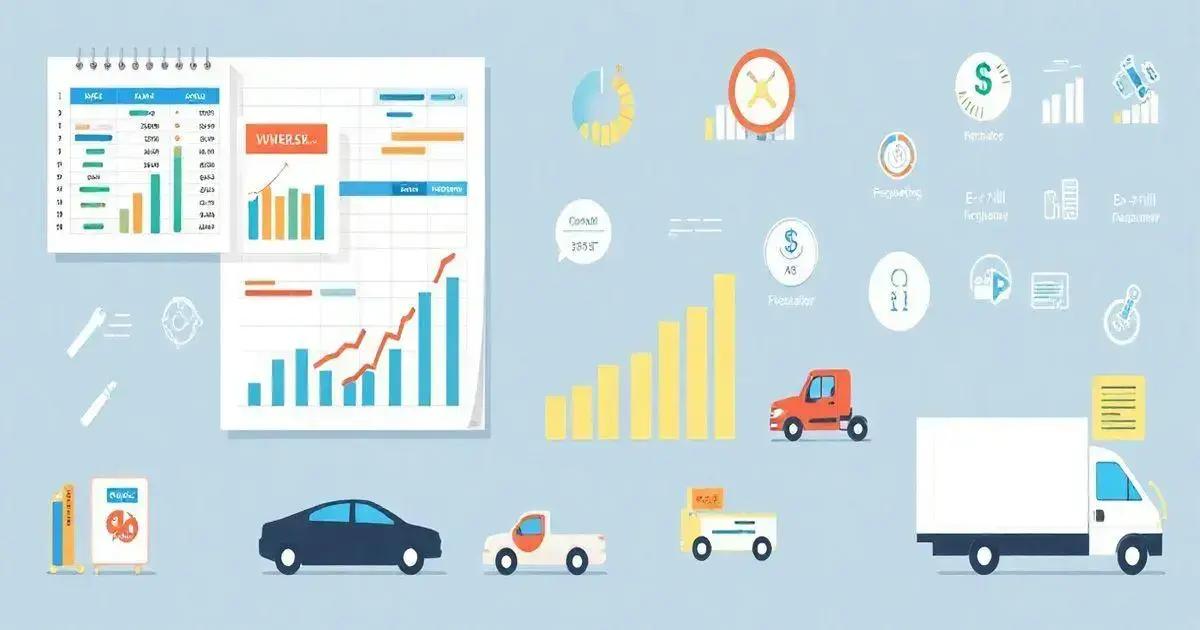5 Essential Features of Fleet Control Worksheet 7.0 Leave a comment
The Fleet Control Worksheet 7.0 is an essential tool for fleet management, featuring an Initial Dashboard, Travel and Cargo Tracking, and Preventive Maintenance Management. It helps fleet managers improve operational efficiency, reduce costs, and enhance accountability through detailed tracking of vehicle performance and maintenance schedules, while also providing insights for data-driven decision-making and ensuring compliance and risk management in the logistics industry.
The Fleet Control Worksheet 7.0 is a powerful tool designed for businesses that operate vehicles as part of their operations. This spreadsheet is packed with features to help you manage your fleet effectively, ensuring that everything from vehicle maintenance to fuel costs is tracked accurately.
Key Features of Fleet Control Worksheet 7.0
The Fleet Control Worksheet 7.0 comes equipped with a variety of features designed to aid in the comprehensive management of your fleet operations. Here are some key features:
Initial Dashboard: This worksheet includes an interactive dashboard that provides a quick overview of essential metrics. You can easily view kilometers driven by each driver, average consumption per vehicle, and maintenance costs. This helps you identify trends and make data-driven decisions.
Travel and Cargo Control: Track each journey made by your vehicles along with the cargo they carry. This feature ensures accountability and provides insights into transport efficiency, allowing you to streamline operations.
Tire Control Management: Keep a close eye on tire conditions and schedules for changes. This feature alerts you when tires need replacement or maintenance, thereby extending their life and ensuring safety on the road.
Preventive Maintenance Tracking: Schedule and manage maintenance tasks to avoid unexpected breakdowns. The worksheet allows you to log all maintenance activities, making it easier to ensure that all vehicles are in optimal condition.
Comprehensive Cost Analysis: Analyze costs related to fuel, maintenance, and other operational expenses. This feature helps you identify areas to cut costs and improve efficiency, ultimately saving your business money.
Overall, the Fleet Control Worksheet 7.0 is a dynamic tool that supports fleet managers in maximizing efficiency and minimizing costs through its robust features.

Initial Dashboard Overview
The Initial Dashboard Overview of the Fleet Control Worksheet 7.0 is designed to provide you with a comprehensive snapshot of your fleet’s performance at a glance. This dashboard aggregates key data points that are essential for effective fleet management. Here’s what you can expect:
Kilometers Driven: The dashboard displays total kilometers driven by each vehicle, allowing you to monitor usage and assess which vehicles are most active.
Fuel Efficiency: View kilometers per liter and average consumption metrics for each vehicle. This helps you identify any fuel inefficiencies and take corrective action by optimizing routes or addressing potential engine issues.
Maintenance Tracking: Get a visual summary of scheduled preventive and corrective maintenance. This section allows you to see at a glance which vehicles are due for service, reducing the risk of unexpected breakdowns.
Cost Analysis: The dashboard presents a breakdown of maintenance costs and average expenses per vehicle. This analysis can help you spot trends over time, such as rising maintenance costs for specific vehicles.
Document Status: Know the status of vehicle and driver documents, such as licenses and insurance. This ensures compliance and minimizes risks associated with documentation lapses.
This Initial Dashboard is not just data; it’s a powerful decision-making tool that enables fleet managers to maintain a clear overview of operations. By centralizing critical metrics, you can make informed decisions that enhance productivity and efficiency.
Travel and Cargo Tracking
The Travel and Cargo Tracking feature within the Fleet Control Worksheet 7.0 is essential for ensuring effective logistics management. This tool allows fleet managers to meticulously monitor every journey and the cargo being transported. Here’s how it works:
Journey Logging: Each trip made by a vehicle is logged with details such as departure and arrival times, routes taken, and total distance covered. This information is crucial for analyzing travel patterns and optimizing routes for efficiency.
Cargo Management: Track the type and amount of cargo being transported for every journey. This feature helps you manage inventories better and ensures that your fleet operates within capacity limits.
Linking Trips to Drivers: Each journey is associated with the specific driver responsible. This accountability fosters better management practices and allows for performance evaluations based on individual driving habits and cargo handling.
Expense Tracking: Record travel-related expenses such as fuel costs, tolls, and maintenance incurred during trips. By tracking these costs, fleet managers can identify areas where efficiencies can be improved and budgets can be optimized.
Real-Time Updates: If connected with a GPS system, this feature can provide real-time tracking of vehicles, allowing for immediate updates and adjustments as needed. This helps in proactively addressing any issues that may arise during a journey.
Overall, the Travel and Cargo Tracking feature is a vital component of the Fleet Control Worksheet 7.0 that enables businesses to manage logistics effectively, reduce costs, and improve service delivery.

Preventive Maintenance Management
The Preventive Maintenance Management feature of the Fleet Control Worksheet 7.0 is designed to help fleet managers maintain their vehicles in optimal condition, reducing the risk of breakdowns and costly repairs. Here’s how it functions:
Maintenance Scheduling: This tool allows you to set up maintenance schedules based on mileage or time intervals. By planning maintenance ahead of time, you can ensure that vehicles receive regular servicing without disrupting operations.
Maintenance Logs: Every maintenance activity is documented in detail. This includes the type of service performed, the date it was completed, and the vehicle it pertains to. Keeping accurate logs helps in tracking the maintenance history of each vehicle and aids in future planning.
Alerts and Reminders: The worksheet can be configured to send alerts when maintenance is due, ensuring that no scheduled service is overlooked. This proactive approach can significantly extend the lifespan of your vehicles.
Cost Tracking: Track expenses associated with preventive maintenance, including parts, labor, and service costs. This data is valuable for budgeting and identifying cost-saving opportunities within your maintenance program.
Performance Analysis: Analyzing maintenance data can help identify patterns or recurring issues with specific vehicles. This insight allows you to address underlying problems early and optimize the maintenance strategy for your fleet.
By integrating Preventive Maintenance Management into your fleet operations, you not only minimize downtime and repair costs but also enhance the overall safety and reliability of your vehicles, leading to smoother operations and improved service delivery.
Benefits of Using Fleet Control Worksheet 7.0
The Fleet Control Worksheet 7.0 offers numerous benefits for fleet managers and businesses that rely on efficient vehicle operations. Here are some key advantages of using this powerful tool:
Improved Efficiency: With detailed tracking of travel, fuel consumption, and maintenance schedules, you can optimize routes and reduce unnecessary expenses, leading to improved operational efficiency.
Cost Savings: By identifying maintenance needs before they become major issues, the worksheet helps in reducing repair costs and downtime. Tracking fuel usage closely also aids in managing fuel expenses, which is a significant cost in fleet management.
Enhanced Accountability: The ability to associate trips with specific drivers fosters accountability. Managers can evaluate driver performance, manage workloads, and enforce safety standards more effectively.
Data-Driven Decisions: The analytical features allow you to gather insights from your fleet operations. You can make informed decisions based on historical data regarding costs, maintenance, and vehicle performance, ultimately leading to better strategic planning.
Compliance and Risk Management: Keeping track of vehicle maintenance and driver documentation ensures compliance with relevant regulations. This reduces the risk of legal issues and enhances overall safety for your fleet.
User-Friendly Interface: The worksheet is designed for ease of use, allowing even those with minimal technical skills to manage their fleet effectively. Intuitive design and structured data entry simplify the process of tracking and reporting.
In conclusion, using the Fleet Control Worksheet 7.0 empowers businesses to streamline their fleet management processes, cut down on costs, and improve overall vehicle performance. By adopting this tool, fleet managers can ensure their operations run smoothly and efficiently.
Conclusion
In summary, the Fleet Control Worksheet 7.0 is an invaluable resource for fleet managers aiming to enhance their operational efficiency and reduce costs.
With its user-friendly interface and comprehensive features, it facilitates effective tracking of vehicle performance, maintenance schedules, and travel logistics.
By leveraging the tools provided by this spreadsheet, businesses can not only streamline their fleet management processes but also make informed, data-driven decisions that lead to cost savings and improved service delivery.
Ultimately, adopting the Fleet Control Worksheet 7.0 empowers organizations to maintain a competitive edge in the logistics and transportation industry.
FAQ – Frequently Asked Questions about Fleet Control Worksheet 7.0
What is the primary function of the Fleet Control Worksheet 7.0?
The primary function of the Fleet Control Worksheet 7.0 is to help fleet managers track vehicle performance, maintenance schedules, travel logistics, and related costs effectively.
Can I use the worksheet for multiple vehicles?
Yes, the Fleet Control Worksheet 7.0 is designed to manage multiple vehicles, allowing you to log and monitor data for each one separately.
Is there a way to set reminders for scheduled maintenance?
Absolutely! The worksheet can be configured to send alerts and reminders when preventive maintenance is due, ensuring you never miss a service.
How does the worksheet help reduce costs?
By providing detailed tracking and analysis of maintenance and fuel consumption, the worksheet helps identify inefficiencies and areas for cost savings, ultimately reducing overall expenses.
Is the Fleet Control Worksheet 7.0 user-friendly?
Yes, it is designed to be user-friendly, making it accessible for those with minimal technical skills to manage their fleet efficiently.
Can I access the worksheet on different devices?
The Fleet Control Worksheet 7.0 works on various versions of Excel but does not support tablet or mobile phone usage. It is best accessed on a computer.

